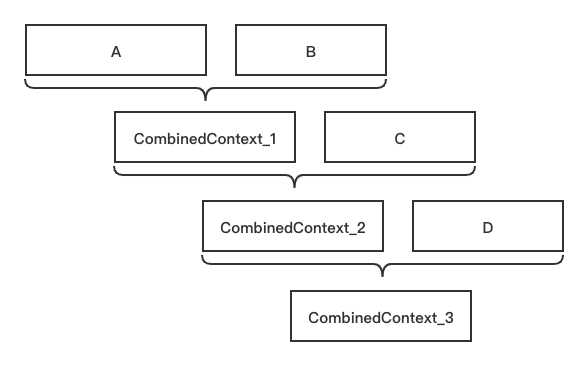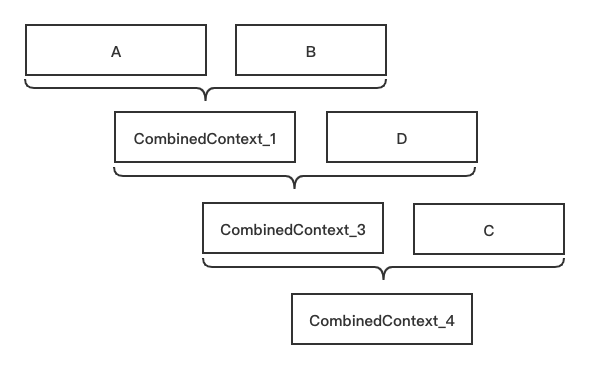Kotlin协程上下文与上下文元素深入理解
目录
- 一.EmptyCoroutineContext
- 二.CombinedContext
- 三.Key与Element
- 四.CoroutineContext
- 五.AbstractCoroutineContextKey与AbstractCoroutineContextElement
一.EmptyCoroutineContext
EmptyCoroutineContext代表空上下文,由于自身为空,因此get方法的返回值是空的,fold方法直接返回传入的初始值,plus方法也是直接返回传入的context,minusKey方法返回自身,代码如下:
public object EmptyCoroutineContext : CoroutineContext, Serializable {
private const val serialVersionUID: Long = 0
private fun readResolve(): Any = EmptyCoroutineContext
public override fun <E : Element> get(key: Key<E>): E? = null
public override fun <R> fold(initial: R, operation: (R, Element) -> R): R = initial
public override fun plus(context: CoroutineContext): CoroutineContext = context
public override fun minusKey(key: Key<*>): CoroutineContext = this
public override fun hashCode(): Int = 0
public override fun toString(): String = "EmptyCoroutineContext"
}
二.CombinedContext
CombinedContext是组合上下文,是存储Element的重要的数据结构。内部存储的组织结构如下图所示:

可以看出CombinedContext是一种左偏(从左向右计算)的列表,这么设计的目的是为了让CoroutineContext中的plus方法工作起来更加自然。
由于采用这种数据结构,CombinedContext类中的很多方法都是通过循环实现的,代码如下:
internal class CombinedContext(
// 数据结构左边可能为一个Element对象或者还是一个CombinedContext对象
private val left: CoroutineContext,
// 数据结构右边只能为一个Element对象
private val element: Element
) : CoroutineContext, Serializable {
override fun <E : Element> get(key: Key<E>): E? {
var cur = this
while (true) {
// 进行get操作,如果当前CombinedContext对象中存在,则返回
cur.element[key]?.let { return it }
// 获取左边的上下文对象
val next = cur.left
// 如果是CombinedContext对象
if (next is CombinedContext) {
// 赋值,继续循环
cur = next
} else { // 如果不是CombinedContext对象
// 进行get操作,返回
return next[key]
}
}
}
// 数据结构左右分开操作,从左到右进行fold运算
public override fun <R> fold(initial: R, operation: (R, Element) -> R): R =
operation(left.fold(initial, operation), element)
public override fun minusKey(key: Key<*>): CoroutineContext {
// 如果右边是指定的Element对象,则返回左边
element[key]?.let { return left }
// 调用左边的minusKey方法
val newLeft = left.minusKey(key)
return when {
// 这种情况,说明左边部分已经是去掉指定的Element对象的,右边也是如此,因此返回当前对象,不需要在进行包裹
newLeft === left -> this
// 这种情况,说明左边部分包含指定的Element对象,因此返回只右边
newLeft === EmptyCoroutineContext -> element
// 这种情况,返回的左边部分是新的,因此需要和右边部分一起包裹后,再返回
else -> CombinedContext(newLeft, element)
}
}
private fun size(): Int {
var cur = this
//左右各一个
var size = 2
while (true) {
cur = cur.left as? CombinedContext ?: return size
size++
}
}
// 通过get方法实现
private fun contains(element: Element): Boolean =
get(element.key) == element
private fun containsAll(context: CombinedContext): Boolean {
var cur = context
// 循环展开每一个CombinedContext对象,每个CombinedContext对象中的Element对象都要包含
while (true) {
if (!contains(cur.element)) return false
val next = cur.left
if (next is CombinedContext) {
cur = next
} else {
return contains(next as Element)
}
}
}
...
}
三.Key与Element
Key接口与Element接口定义在CoroutineContext接口中,代码如下:
public interface Key<E : Element>
public interface Element : CoroutineContext {
// 一个Key对应着一个Element对象
public val key: Key<*>
// 相等则强制转换并返回,否则则返回空
public override operator fun <E : Element> get(key: Key<E>): E? =
@Suppress("UNCHECKED_CAST")
if (this.key == key) this as E else null
// 自身与初始值进行fold操作
public override fun <R> fold(initial: R, operation: (R, Element) -> R): R =
operation(initial, this)
// 如果要去除的是当前的Element对象,则返回空的上下文,否则返回自身
public override fun minusKey(key: Key<*>): CoroutineContext =
if (this.key == key) EmptyCoroutineContext else this
}
四.CoroutineContext
CoroutineContext接口定义了协程上下文的基本行为以及Key和Element接口。同时,重载了"+"操作,相关代码如下:
public interface CoroutineContext {
public operator fun <E : Element> get(key: Key<E>): E?
public fun <R> fold(initial: R, operation: (R, Element) -> R): R
public operator fun plus(context: CoroutineContext): CoroutineContext =
// 如果要与空上下文相加,则直接但会当前对象,
if (context === EmptyCoroutineContext) this else
// 当前Element作为初始值
context.fold(this) { acc, element ->
// acc:已经加完的CoroutineContext对象
// element:当前要加的CoroutineContext对象
// 获取从acc中去掉element后的上下文removed,这步是为了确保添加重复的Element时,移动到最右侧
val removed = acc.minusKey(element.key)
// 去除掉element后为空上下文(说明acc中只有一个Element对象),则返回element
if (removed === EmptyCoroutineContext) element else {
// ContinuationInterceptor代表拦截器,也是一个Element对象
// 下面的操作是为了把拦截器移动到上下文的最右端,为了方便快速获取
// 从removed中获取拦截器
val interceptor = removed[ContinuationInterceptor]
// 若上下文中没有拦截器,则进行累加(包裹成CombinedContext对象),返回
if (interceptor == null) CombinedContext(removed, element) else {
// 若上下文中有拦截器
// 获取上下文中移除到掉拦截器后的上下文left
val left = removed.minusKey(ContinuationInterceptor)
// 若移除到掉拦截器后的上下文为空上下文,说明上下文left中只有一个拦截器,
// 则进行累加(包裹成CombinedContext对象),返回
if (left === EmptyCoroutineContext) CombinedContext(element, interceptor) else
// 否则,现对当前要加的element和left进行累加,然后在和拦截器进行累加
CombinedContext(CombinedContext(left, element), interceptor)
}
}
}
public fun minusKey(key: Key<*>): CoroutineContext
... // (Key和Element接口)
}
- 1.plus方法图解
假设我们有一个上下文顺序为A、B、C,现在要按顺序加上D、C、A。
1)初始值A、B、C

2)加上D

3)加上C

4)加上A

- 2.为什么要将ContinuationInterceptor放到协程上下文的最右端?
在协程中有大量的场景需要获取ContinuationInterceptor。根据之前分析的CombinedContext的minusKey方法,ContinuationInterceptor放在上下文的最右端,可以直接获取,不需要经过多次的循环。
五.AbstractCoroutineContextKey与AbstractCoroutineContextElement
AbstractCoroutineContextElement实现了Element接口,将Key对象作为构造方法必要的参数。
public abstract class AbstractCoroutineContextElement(public override val key: Key<*>) : Element
AbstractCoroutineContextKey用于实现Element的多态。什么是Element的多态呢?假设类A实现了Element接口,Key为A。类B继承自类A,Key为B。这时将类B的对象添加到上下文中,通过指定不同的Key(A或B),可以得到不同类型对象。具体代码如下:
// baseKey为衍生类的基类的Key
// safeCast用于对基类进行转换
// B为基类,E为衍生类
public abstract class AbstractCoroutineContextKey<B : Element, E : B>(
baseKey: Key<B>,
private val safeCast: (element: Element) -> E?
) : Key<E> {
// 顶置Key,如果baseKey是AbstractCoroutineContextKey,则获取baseKey的顶置Key
private val topmostKey: Key<*> = if (baseKey is AbstractCoroutineContextKey<*, *>) baseKey.topmostKey else baseKey
// 用于类型转换
internal fun tryCast(element: Element): E? = safeCast(element)
// 用于判断当前key是否是指定key的子key
// 逻辑为与当前key相同,或者与当前key的顶置key相同
internal fun isSubKey(key: Key<*>): Boolean = key === this || topmostKey === key
}
getPolymorphicElement方法与minusPolymorphicKey方法
如果衍生类使用了AbstractCoroutineContextKey,那么基类在实现Element接口中的get方法时,就需要通过getPolymorphicElement方法,实现minusKey方法时,就需要通过minusPolymorphicKey方法,代码如下:
public fun <E : Element> Element.getPolymorphicElement(key: Key<E>): E? {
// 如果key是AbstractCoroutineContextKey
if (key is AbstractCoroutineContextKey<*, *>) {
// 如果key是当前key的子key,则基类强制转换成衍生类,并返回
@Suppress("UNCHECKED_CAST")
return if (key.isSubKey(this.key)) key.tryCast(this) as? E else null
}
// 如果key不是AbstractCoroutineContextKey
// 如果key相等,则强制转换,并返回
@Suppress("UNCHECKED_CAST")
return if (this.key === key) this as E else null
}
public fun Element.minusPolymorphicKey(key: Key<*>): CoroutineContext {
// 如果key是AbstractCoroutineContextKey
if (key is AbstractCoroutineContextKey<*, *>) {
// 如果key是当前key的子key,基类强制转换后不为空,说明当前Element需要去掉,因此返回空上下文,否则返回自身
return if (key.isSubKey(this.key) && key.tryCast(this) != null) EmptyCoroutineContext else this
}
// 如果key不是AbstractCoroutineContextKey
// 如果key相等,说明当前Element需要去掉,因此返回空上下文,否则返回自身
return if (this.key === key) EmptyCoroutineContext else this
}
到此这篇关于Kotlin协程上下文与上下文元素深入理解的文章就介绍到这了,更多相关Kotlin上下文内容请搜索我们以前的文章或继续浏览下面的相关文章希望大家以后多多支持我们!

